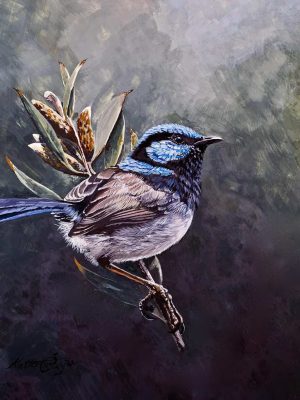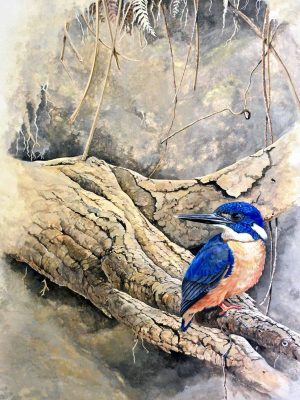Showing all 17 results

Cape Raoul, southern Tasmania
Watercolour and gouache on 640 gsm hot press Lana rag paper - H80 cms x W 100 cms. Unframed
The Short-tailed Shearwater (Ardenna tenuirostris) is Australia’s most numerous seabird. During breeding season, millions converge on many small islands around southern Australia, with their stronghold in Bass Strait. Cape Raoul is at the southernmost tip of the Tasman Peninsula in Tasmania. The cape features rock platforms, towering 300 metre cliffs, columns and off-shore islands.
Please get in contact for more information.

Limited Edition print size: 80 cm x 100 cm.
'The Feeding Frenzy ' - Tasmanian Shy Albatross (Thelassarche cauta)
The IUCN classifies this species as near threatened with less than 25,000 breeding animals. Today, longline fishing still impacts this species but their numbers have been maintained despite this threat. The shy albatross feeds by a combination surface-seizing and some pursuit diving – it has been recorded diving as deep as 5 m
*Price includes postage anywhere within Australia

Limited edition print size 100 cm x 80 cm
The Tasmanian masked owl (Tyto novaehollandiae castanops) is a bird in the barn owl family Tytonidae that is endemic to the island state of Tasmania, Australia. It is the largest subspecies of the Australian masked owl, the largest Tyto owl in the world, and is sometimes considered a full species. The sub-specific name castanops, meaning “chestnut-faced”, comes from the colouring of the facial disc.
*Price includes postage anywhere within Australia.

Print Size: 100cm x 60cm
Soaring majestically above the oceans between Australia and Africa, the shy albatross appears not to have a care in the world. Breeding only on Australian islands, it can live for up to 40 years and enjoys the partnership of a life-long mate.
Pairs are faithful –to each other and their breeding sites on just three remote islands off Tasmania. They breed annually and produce a single egg, which is incubated for 72 days. Both parents tend the demanding chick for the first five months of its life and that fledgling will return to the same breeding colony when it matures, but not until at least three years of age.
*Price includes postage anywhere within Australia.

Print Size: 80cm x 60cm
The Australasian gannet (Morus serrator), also known as Australian gannet and tākapu, is a large seabird of the booby and gannet family, Sulidae. Adults are mostly white, with black flight feathers at the wingtips and lining the trailing edge of the wing. The central tail feathers are also black. The head is tinged buff-yellow, with a pale blue-grey bill edged in black, and blue-rimmed eyes. Young birds have mottled plumage in their first year, dark above and light below. The head is an intermediate mottled grey, with a dark bill. The birds gradually acquire more white in subsequent seasons until they reach maturity after five years.
*Price includes postage anywhere within Australia.

Print Size: 80cm x 60cm
Soaring majestically above the oceans between Australia and Africa, the shy albatross appears not to have a care in the world. Breeding only on Australian islands, it can live for up to 40 years and enjoys the partnership of a life-long mate.
Pairs are faithful –to each other and their breeding sites on just three remote islands off Tasmania. They breed annually and produce a single egg, which is incubated for 72 days. Both parents tend the demanding chick for the first five months of its life and that fledgling will return to the same breeding colony when it matures, but not until at least three years of age.
This is a signed Limited Edition print.
*Price includes postage anywhere within Australia.

This Limited Edition Print is 60 cm x 80 cm
The Australasian gannet (Morus serrator), also known as Australian gannet and tākapu, is a large seabird of the booby and gannet family, Sulidae. Adults are mostly white, with black flight feathers at the wingtips and lining the trailing edge of the wing. These amazing birds dive from heights of 30 metres, entering the water at speeds of up to 100 km/h.
This is an Archival Print.
Price includes postage within Australia

Print Size: 80cm x 60cm
The king penguin (Aptenodytes patagonicus) is the second largest species of penguin, smaller, but somewhat similar in appearance to the emperor penguin. There are two subspecies: A. p. patagonicus and A. p. halli; patagonicus is found in the South Atlantic and halli in the South Indian Ocean (at the Kerguelen Islands, Crozet Island, Prince Edward Islands and Heard Island and McDonald Islands) and at Macquarie Island.[2]
King penguins mainly eat lantern fish, squid and krill. On foraging trips king penguins repeatedly dive to over 100 meters (300 ft), and have been recorded at depths greater than 300 meters (1,000 ft).[3]
King penguins breed on the sub-antarctic islands at the northern reaches of Antarctica, South Georgia, and other temperate islands of the region.
This is an archival print. To view our limited edition prints click here.
*Price includes postage anywhere within Australia.

Print Size: 45cm x 30cm (no matt surround)
The white-bellied sea eagle (Haliaeetus leucogaster), also known as the white-breasted sea eagle, is a large diurnal bird of prey in the family Accipitridae. Originally described by Johann Friedrich Gmelin in 1788, it is closely related to Sanford's sea eagle of the Solomon Islands, and the two are considered a superspecies. A distinctive bird, the adult white-bellied sea eagle has a white head, breast, under-wing coverts and tail. The upper parts are grey and the black under-wing flight feathers contrast with the white coverts. The tail is short and wedge-shaped as in all Haliaeetus species. Like many raptors, the female is slightly larger than the male, and can measure up to 90 cm (35 in) long with a wingspan of up to 2.2 m (7.2 ft), and weigh 4.5 kg (9.9 lb).
This is an archival print. To view our limited edition prints click here.
*Price includes postage anywhere within Australia.

Print Size: 20cm x 20cm (with matt surround)
The superb fairywren (Malurus cyaneus) is a passerine bird in the Australasian wren family, Maluridae, and is common and familiar across south-eastern Australia. The species is sedentary and territorial, also exhibiting a high degree of sexual dimorphism; the male in breeding plumage has a striking bright blue forehead, ear coverts, mantle, and tail, with a black mask and black or dark blue throat. Non-breeding males, females and juveniles are predominantly grey-brown in colour; this gave the early impression that males were polygamous, as all dull-coloured birds were taken for females. Six subspecies groups are recognized: three larger and darker forms from Tasmania, Flinders and King Island respectively, and three smaller and paler forms from mainland Australia and Kangaroo Island.
This is an archival print. To view our limited edition prints click here.
*Price includes postage anywhere within Australia.

Immature Tasmanian Masked Owl (Tyto novaehollandiae castonops)
Montgomery (the owl) resides at the Raptor Refuge of Tasmania, Kettering. He enjoys educating school groups and takes his ambassadorial role very seriously.
(My sincere thanks to Luke O’Brien for his superb reference images)
This original piece is SOLD.

100 cm x 80 cm Framed. Graphite on 640 gsm hot press rag paper
The Argonaut, or paper nautilus, is actually a pelagic octopus. Females make a parchment-like shell (up to 30cm) which is used to carry incubating eggs and to trap surface air, which helps them maintain buoyancy.
This original piece is SOLD.
110 cm x 90 cm Graphite on 640 gsm hot press rag paper
The Aberdeen Angus, sometimes simply Angus, is a Scottish breed of small beef cattle. It derives from cattle native to the counties of Aberdeenshire and Angus in north-eastern Scotland. Angus cattle were first introduced to Tasmania (then known as Van Diemen's Land) in the 1820s and to the southern mainland in 1840. The breed is now found in all Australian states and territories, including King Island. With lush pastures and a temperate climate, the island is perfect for breeding the happiest, grass-fed cattle on the planet.
This original piece is SOLD. To view our limited edition prints click here.

Cape Raoul, southern Tasmania
Watercolour and gouache on 640 gsm hot press Lana rag paper - H120 cms x W 150 cms. Framed
The Short-tailed Shearwater (Ardenna tenuirostris) is Australia’s most numerous seabird. During breeding season, millions converge on many small islands around southern Australia, with their stronghold in Bass Strait. Cape Raoul is at the southernmost tip of the Tasman Peninsula in Tasmania. The cape features rock platforms, towering 300 metre cliffs, columns and off-shore islands.
This original piece is SOLD
Please get in contact for more information.

Print Size: 25cm x 25cm (with matt surround)
The Southern fairy prion is a member of the Pachyptila genus, and along with the blue petrel makes up the prions. They in turn are members of the Procellariidae family, and the Procellariiformes order. The prions are small and typically eat just zooplankton;[2] however as a member of the Procellariiformes, they share certain identifying features. First, they have nasal passages that attach to the upper bill called naricorns. Although the nostrils on the albatross are on the sides of the bill. The bills of Procellariiformes are also unique in that they are split into between 7 and 9 horny plates. They produce a stomach oil made up of wax esters and triglycerides that is stored in the proventriculus. This is used against predators as well as an energy rich food source for chicks and for the adults during their long flights.[3] Finally, they also have a salt gland that is situated above the nasal passage and helps desalinate their bodies, due to the high amount of ocean water that they imbibe. It excretes a high saline solution from their nose.
This is an archival print.
*Price includes postage anywhere within Australia.

Print Size: 100 cm x 80 cm
With its combination of royal-blue plumage on its upperparts contrasting with orange on its underparts, the Azure Kingfisher is one of the smallest and most dazzling kingfishers in Australia. This diminutive species inhabits the vegetation beside waterways and other wetlands, where it often perches on low, overhanging branches, searching for its prey of fish, crustaceans and aquatic insects, captured by shallow plunging into the water. Anglers on lonely rivers are sometimes surprised to find an Azure Kingfisher perched quietly on their fishing rods instead of a branch.
This is an archival print. To view our limited edition prints click here.
*Price includes postage anywhere within Australia.

The Tasmanian masked owl (Tyto novaehollandiae castanops) is a bird in the barn owl family Tytonidae that is endemic to the island state of Tasmania, Australia. It is the largest subspecies of the Australian masked owl, the largest Tyto owl in the world, and is sometimes considered a full species. The sub-specific name castanops, meaning “chestnut-faced”, comes from the colouring of the facial disc.
This original print is SOLD. To view it as a limited edition print, click here.
